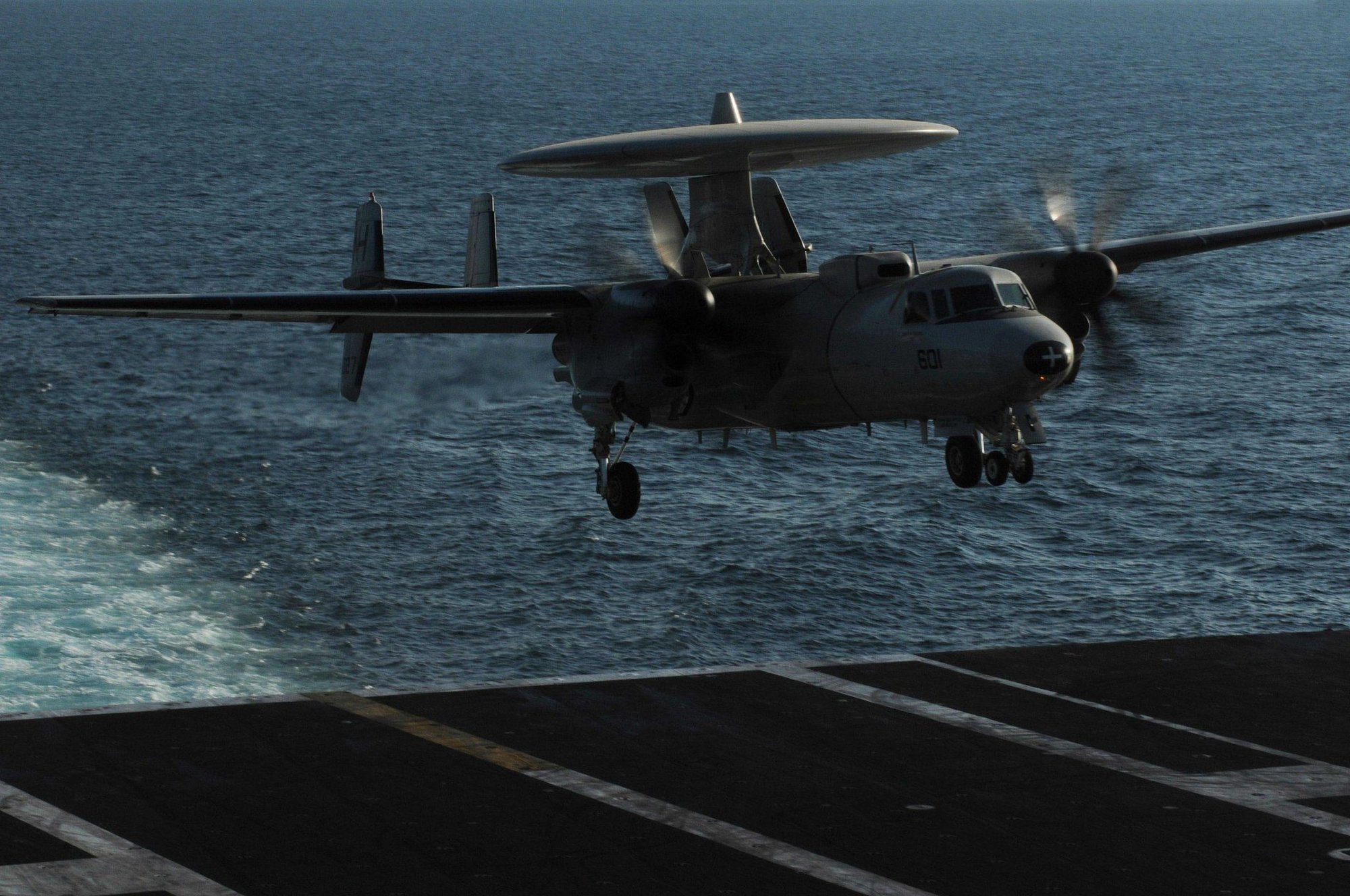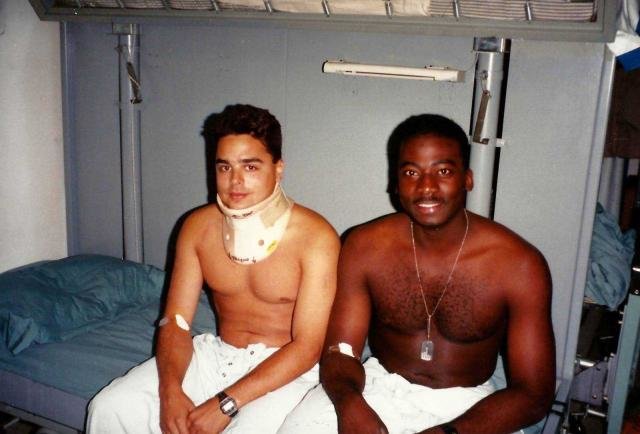The Day a US Navy F/A-18 Hornet Shot Down One of Their Own Pilotless Aircraft

An E2-C Hawkeye assigned to the “Wallbangers” of Carrier Airborne Early Warning Squadron 117 lands aboard the aircraft carrier USS Nimitz. Photo by Petty Officer 3rd Class John Wagner, courtesy of DVIDS.
In the clear, sunny skies of July 8, 1991, an E2-C Hawkeye early warning and command control aircraft flew over a deep blue Mediterranean Sea. The plane held a steady course, its prop engines turning beneath its huge, round radar array. It had launched from the USS Forrestal, an aircraft carrier supporting the just-concluded Desert Storm, and the E-2C was headed toward Syria. But at this moment, it was cruising over blue, clear waters.
And then, at a chosen moment, a Navy F/A-18C Hornet from the same ship and cruising behind the E-2C released a burst from its 20 mm Vulcan cannon, blowing the Hawkeye out of the sky.
The shootdown — an American fighter downing another American warplane — was not a friendly fire incident, nor did it result in any casualties. The E-2C had become the rarest of things in aviation: a runaway aircraft, flying with no crew on board. The plane’s pilots had bailed out, believing the plane was doomed by an engine fire. But it survived and flew on, headed toward land — possibly toward populated areas. Unsure where it would crash, Navy commanders decided to shoot it down over open waters before it reached the coast.
For three months, Hawkeye aircrews on the USS Forrestal had provided command and control for air support in northern Iraq in the aftermath of Desert Storm, protecting Kurds attempting to flee Iraqi dictator Saddam Hussein, an operation dubbed Provide Comfort.

Steeljaw 601 was among the last aircraft to launch that day because it needed last-second engine maintenance. Throughout the Forrestal’s deployment, all the E-2C had experienced false engine-fire warnings, which proved to cloud the judgment of the aircrew in the cockpit. At approximately 11:54 a.m., July 8, 1991, Steeljaw 601 lifted off, but only 20 seconds into the flight the right engine’s fire-warning light indicated a problem. The two pilots immediately declared an emergency while the three naval flight officers (NFOs) looked out their windows at the engines.
“We told the [Forrestal] tower that we would need eight minutes to dump fuel to get to a max trap [landing] weight,” Lt. Vincent “Vinnie” Bowhers, the pilot in command of the aircraft, recalled in a Naval History article, “Hawkeye Bailout at 4,000 Feet,” by Tom Siu, from the US Naval Institute. He was positioned in the right seat of the cockpit.
NFO Lt. j.g. Terry Morris screamed, “Yurch, we’re on fire!” Lt. Cmdr. John “Yurch” Yurchak, the combat information center officer, instinctively abandoned the possibility of saving the aircraft and prioritized the safety of the aircrew. He conferred with Bowhers, one of the most senior lieutenants on board, and ordered a bailout. “John, get out!” Bowhers yelled to Lt. j.g. John Lemmon. Procedure called for the pilot in the left seat, where Lemmon was seated, to bail last, but since he was a first-tour pilot, Bowhers ordered his co-pilot to jump before him.
Bowhers considered lowering the wing flaps, which are typically used to slow an aircraft. But he knew the extra stress on the right wing could destroy it if a fire had caused damage. “The wing would have broken off,” Bowhers recalled.
In order to safely bail out of the fiery plane, Bowhers leveled it off, successfully engaged autopilot, and brought it down to a speed of approximately 180 knots. All three NFOs bailed out, then Lemmon, then Bowhers. An F-14 Tomcat, the last to launch from the Forrestal, heard Steeljaw 601’s mayday call and intercepted them. Becoming the on-scene search-and-rescue commanders, pilot Lt. Coby Loessberg and radar intercept officer Lt. Cmdr. Doug Allen radioed “good chutes” for all the jumpers.

“You could see the parachutes, but when they were in the water, they disappeared,” Loessberg would recall.
While the search-and-rescue operation worked to save the lives of the missing aircrew at sea, the pilotless Hawkeye coasted into Syrian airspace. Lt. William “Maggot” Reilly scrambled in his F/A 18-C Hornet to the last known position of Steeljaw 601 and was ordered to shoot down the plane. The Navy feared that, if the plane were left alone, it would become hazardous to other ships or worse, crash in a populated area in Syria or Cyprus. Reilly intercepted the Hawkeye and broke the plane apart with his 20 mm canon. The shootdown, remarkably, was the first “aerial victory” for the USS Forrestal in the carrier’s 37-year history.
While there was no armament on the plane, Retired Rear Adm. Eugene Carroll Jr., a former commander of a Mediterranean carrier task force, believed the sensitive equipment that was on board wouldn’t have survived the crash. “There would be some encryption devices, a few classified technical manuals and some intelligence reports, but probably nothing above the secret classification,” he said in an interview in 1991.
According to the Daily Press, “Besides, [Carroll] said, much of that equipment, as well as the plane, likely would be destroyed in a crash.”
Editor’s note: This article has been updated to more clearly attribute source material to “Hawkeye Bailout at 4,000 Feet” by Tom Siu in the August 2021 issue of Naval History magazine.
Read Next: The Day ‘Hell Rained Down’ on the Only Firefighters Killed by a Foreign Power on US Soil

Matt Fratus is a history staff writer for Coffee or Die. He prides himself on uncovering the most fascinating tales of history by sharing them through any means of engaging storytelling. He writes for his micro-blog @LateNightHistory on Instagram, where he shares the story behind the image. He is also the host of the Late Night History podcast. When not writing about history, Matt enjoys volunteering for One More Wave and rooting for Boston sports teams.
BRCC and Bad Moon Print Press team up for an exclusive, limited-edition T-shirt design!
BRCC partners with Team Room Design for an exclusive T-shirt release!
Thirty Seconds Out has partnered with BRCC for an exclusive shirt design invoking the God of Winter.
Lucas O'Hara of Grizzly Forge has teamed up with BRCC for a badass, exclusive Shirt Club T-shirt design featuring his most popular knife and tiomahawk.
Coffee or Die sits down with one of the graphic designers behind Black Rifle Coffee's signature look and vibe.
Biden will award the Medal of Honor to a Vietnam War Army helicopter pilot who risked his life to save a reconnaissance team from almost certain death.
Ever wonder how much Jack Mandaville would f*ck sh*t up if he went back in time? The American Revolution didn't even see him coming.
A nearly 200-year-old West Point time capsule that at first appeared to yield little more than dust contains hidden treasure, the US Military Academy said.












